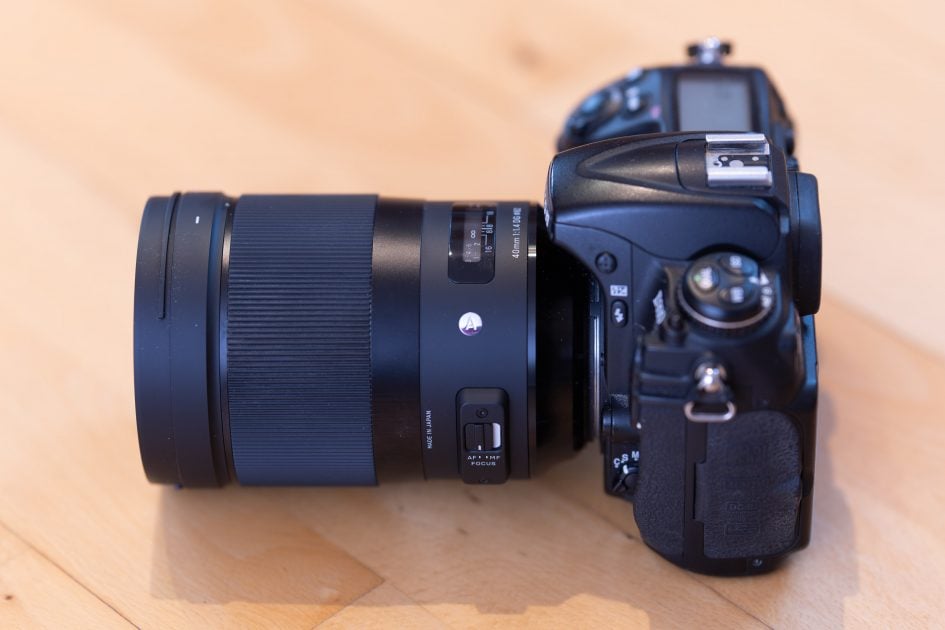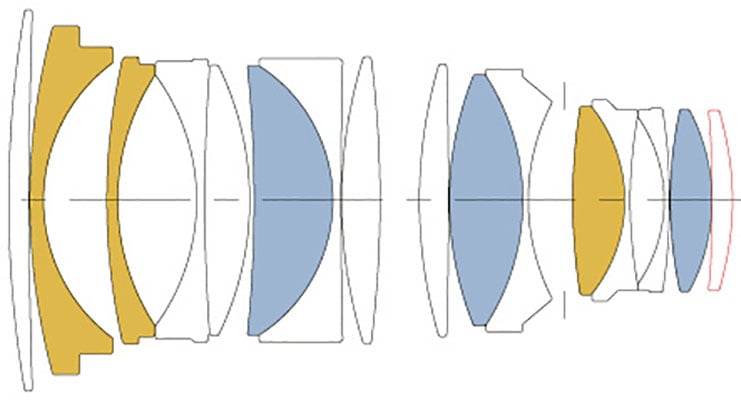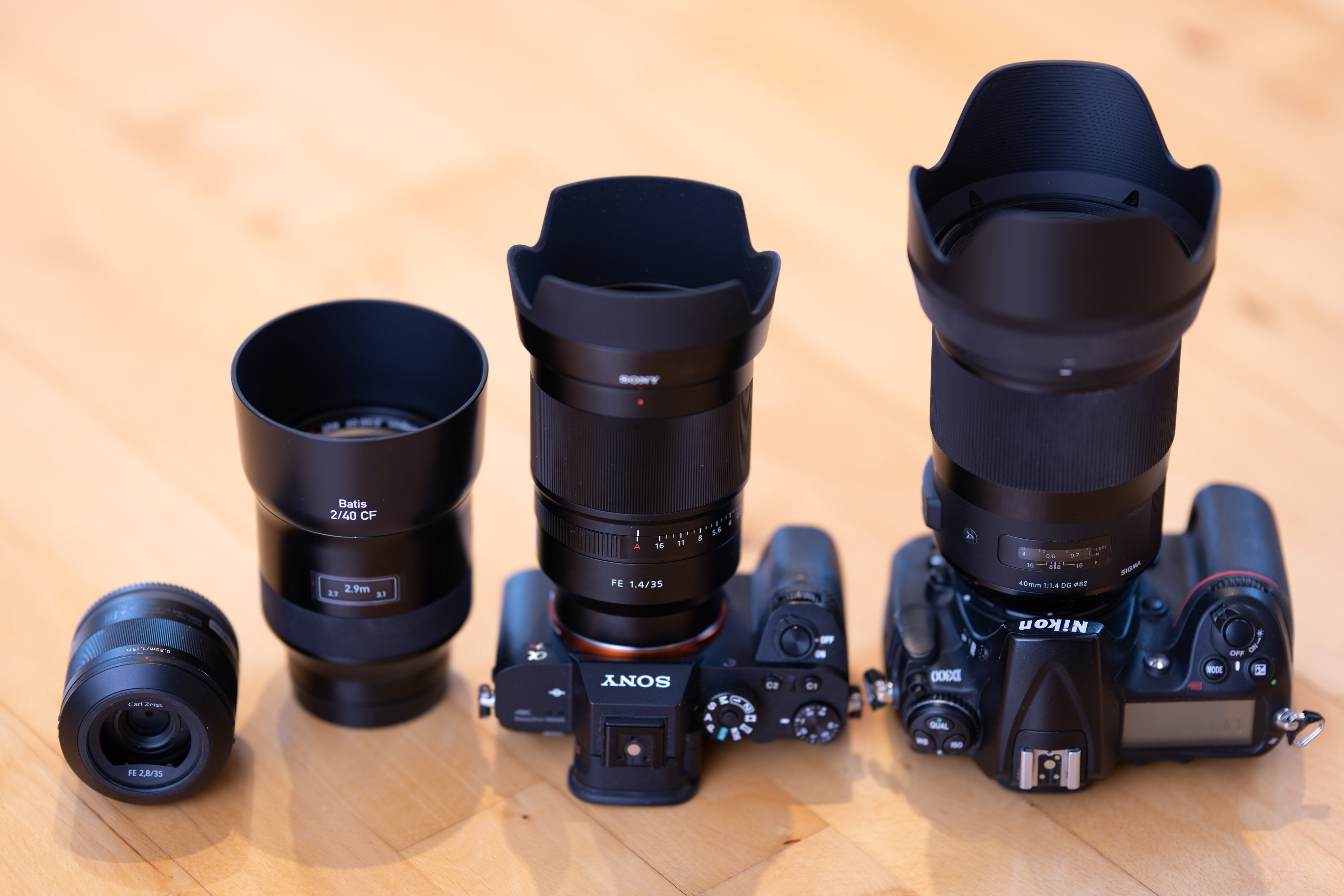Sigma 40mm f1.4 Art review
Summary
 The Sigma 40mm f1.4 Artwork is a short basic prime lens designed for broad-frame sensors and accessible in Nikon F, Canon EF and Sigma mounts with native Sony E and Leica L versions arriving later in 2019. The 40mm length waterfall between Thomas More common 35mm and 50mm models, but is actually closer to 'convention' coverage than either, ensuant in a natural perspective that's saint for generalized-use. Originally designed for DSLRs, the crystalline lens is on the large and heavy side even compared to its already fairly goodish Artistry siblings, advisement 1.2 to 1.3kg depending on the mount. But If you posterior live with the size and burthen, the Sigma 40mm f1.4 Art is a winner: Sharp into the corners of a full-frame sensor, very good electrical resistance against burn up, glare and ghosting plus a nice background Bokeh and selfsame low color aberrations and coma. In concert with thorough weather condition-sealing and firm habitus timber the lens justifies its price and although focus shift can lead astray phase-detect AF on DSLRs the Sigma 40mm f1.4 Art clearly earns a Extremely Recommended!
The Sigma 40mm f1.4 Artwork is a short basic prime lens designed for broad-frame sensors and accessible in Nikon F, Canon EF and Sigma mounts with native Sony E and Leica L versions arriving later in 2019. The 40mm length waterfall between Thomas More common 35mm and 50mm models, but is actually closer to 'convention' coverage than either, ensuant in a natural perspective that's saint for generalized-use. Originally designed for DSLRs, the crystalline lens is on the large and heavy side even compared to its already fairly goodish Artistry siblings, advisement 1.2 to 1.3kg depending on the mount. But If you posterior live with the size and burthen, the Sigma 40mm f1.4 Art is a winner: Sharp into the corners of a full-frame sensor, very good electrical resistance against burn up, glare and ghosting plus a nice background Bokeh and selfsame low color aberrations and coma. In concert with thorough weather condition-sealing and firm habitus timber the lens justifies its price and although focus shift can lead astray phase-detect AF on DSLRs the Sigma 40mm f1.4 Art clearly earns a Extremely Recommended!
Pip out now!
Check prices happening the Sigma 40mm f1.4 ART at Amazon, B&H, Adorama or WEX! Alternatively get yourself a copy of my In Camera book or delicacy me to a chocolate! Thanks!
Sigma 40mm f1.4 Art review -
- Written past
In depth
The Sigma 40mm f1.4 Artistic production is a short standard prime lens designed to cover full-skeleton sensors and available in Nikon F, Canon EF and Sigma mounts with native Sony E and Leica L versions arriving later in 2019. Announced in September 2018, IT's Sigma's 10th gargantuan aperture full-frame lens in the renown Art series ranging from 14mm busy 135mm central length.
On a full-frame tv camera the Sigma 40mm f1.4 Art delivers a field-of-view that's 10 degrees wider than the standard 50mm lens (57 vs 47 degrees) and 7 degrees narrower than from a 35mm electron lens. Information technology can still be considered a "normal" electron lens as its 40mm point length is so closer to the 43mm slanted of a full-frame sensor than a 50mm lens is. And then images shot with this lens should produce a very instinctive and immersive linear perspective when viewed from a standard distance (adequate to the diagonal of the print or monitor/screen). Use it along an APSC crop sensor and the Sigma 40mm f1.4 Art delivers a field of view that is equivalent to a 60mm lens. Combined with a bright f1.4 speed it is ideal for available-light use up and should also deliver shallow depth-of-field effects and screen backgroun blur that are slightly better than from a 50mm f1.8 lens.
To catch out whether the optical performance of the new 40mm f1.4 Art makes it a honoured member of Sigma's Art line I tested it on a 46MP Nikon Z7 (with FTZ-adapter) and liken it against the Zeiss 40mm f2.0 Batis and the Sony 35mm f1.4 ZA shot on the 42MP Sony A7R II body.

Facts from the catalog
American Samoa usual I'll have a view the field of study data of the Sigma 40mm f1.4 Art first. I've rated the features with a [+] (or [++]), when it's better than average out or even state of the art, a [0] if information technology's standard Beaver State just average, and [-] if thither's a disadvantage. For comparison I usage the Sony 35mm f1.4 ZA and the Zeiss 40mm f2.0 Genus Batis ("Sony ZA" resp. "Zeiss Batis" for short).
Sizing (diameter x distance): With a diameter of 88mm (3.5in.) the length of the lens varies with the mount: with a Nikon F-mountain IT's 129mm (5.1in.), with a Sony E-mount it's 157mm (6.2in.). Put a Nikon FTZ-arranger connected the F-ride version to shoot on a Nikon Z body and you destruction up with 159mm length. The lens hood adds 50mm (2.0in.) and is 106mm in diameter delivery the total length to a massive 21cm (8.2in.) before of a mod mirrorless body. This is a huge lens plane topping the monstrous Zeiss Otus lenses in length and clearly display its inheritance as a DSLR intent that has to header with the bigger flange distances. The Sony ZA is not a small lens either but at 79 x 112mm plus 37mm for the lens hood (98mm diameter) IT looks small in comparison. And the Zeiss Genus Batis is fifty-fifty smaller at 81 x 87mm + 40mm for the Lens hood (91mm diameter). [-]
Slant: 1177g (42 oz.) in the F-setting version addition 61g for the electron lens hood. Sigma does non list the weight of the E-mount version which has a 28mm longer "throat" but I feign that's an additional 100g. If you role the F-mount lens on a Nikon Z body the FTZ-adapter adds 133g (4.7 oz.). The Sony ZA is only half American Samoa soggy at 630g (22 oz.) asset 30g crystalline lens hood. The Zeiss Batis is incredibly light in equivalence at only 362g (13 oz.) plus 32g for the crystalline lens hood. But so it has a one stop slower focal ratio. [-]
Optics: The lens is a pretty complex design with 16 elements (including 6 exceptional dispersion elements and one aspherical element) in 12 groups. That makes 24 glass/free-flying surfaces where reflections can cause problems. There's fluorine finishing on the front to repel water, dust, and dirt and should relieve oneself for easier cleansing. The Sony ZA has 12 elements in 8 groups, the Zeiss Batis has 9 elements in 8 groups. [+]

Closest focus on distance is 0.36m (14in.) in manual of arms focus with a magnification of 1:5.6. This results in a working distance of 18cm when the lens hood is removed. A blowup of 1:10 is achieved at 0.55m distance. The Sony ZA achieves a similar magnification of 1:5.3 just the Zeiss Batis goes down to 1:3.1 at 0.24m with a working aloofness of 14cm. [0]
Separate out-thread: 82mm, so you possibly need new dear filters. The Sony ZA takes littler/cheaper 72mm filters, the Zeiss Batis 67mm. [0]
Image stabilization: No optical stabilisation of the lense. The Sony A7 or Nikon Z bodies provide built-in sensor-shift stabilization. Same with the Sony ZA and the Zeiss Batis. [0]
Car focus: Intrinsical AF drive. Manual-focus override is by simply turning the focus annulus. The centerin mob has a direct running mechanical coupling between the focus ring and the focus action and offers distance and dof markings. The Zeiss Batis offers a video display for focus outdistance and depth of force field and its gearing is not-linear: this allows for even more precise manual focus when turned slowly but makes smooth focus pulling for videographers nigh out of the question. Sharpen happening the Sony ZA whole kit and boodle the same as with the Zeiss Batis only it has zero display of space operating theatre dof. [+]
Covers fully frame/FX Beaver State smaller. Same with the competition. [+]
Damage: The lens system currently sells for 1200 EUR (incl. 19% VAT) / 1400 USD. The Sony ZA is the most expensive lens therein trio at 1500 EUR/USD with the Zeiss Batis in between at 1300 EUR/USD. [0]
The Sigma Art lens comes with a padded pouch plus strap and the lens strong-arme is included. It is revocable for transport and has a locking mechanism to prevent it from accidentally falling off. The Sony ZA has a soft pouch and the lens cowl has no lock. The Zeiss Batis comes with the lens system strong-arme but without a pouch. [+]
Sigma's service can change the mount of the lens between Nikon, Canon, Sony, Sigma, and L-climb (at a cost). This is a unique feature that atomic number 102 other manufacturer offers. [++]
Aperture ring: no, just like the Zeiss Batis. The Sony ZA offers an aperture ring with 1/3 stop clicks which can constitute turned turned for continuous, flowing, and make noise-slaveless operation. [0]
Sealing: yes, a rubber grommet at the electron lens-mount plus further special weather condition-waterproofing throughout the construction, just like the Zeiss Batis. The Sony ZA is similarly sealed inside simply lacks the rubberize sealing at the lens-jump on. [+]
The score in the "features-department" is 2[-]/5[0]/7[+], the most distinguishing features of the lens being its huge size and heavy weight – unluckily. On a mirrorless body it looks and feels grotesquely unbalanced with the lens weighing twice as much American Samoa the body. On the empiricist philosophy face the lens system seems well built and its finishing and weather sealing should make for distract-free cognitive process under demanding conditions. Plus Sigma offers the unique selection to get the lens-mount swapped.
Four fisheye prime lenses

Above from left to right: Sony 35mm f2.8 ZA, Zeiss 40mm f2.0 Batis, Sony 35mm f1.4 ZA, Sigma 40mm f1.4 Art
Alternatives
If you want a 40mm lens with an f1.4 stop number and autofocus there is no alternative. The closest is a 35mm f1.4 Lens or slower or manual center lenses.
- Sigma offers the AF 35mm 1.4 DG HSM Artwork for a relatively low price of 750 EUR / 900 USD. It's an exteroception design from 2012 for DSLRs which is also available in E-mount since 2018. Realise my Sigma 35mm f1.4 Art review where it came Extremely Recommended when tested on a 36MP Nikon D800. At 755g for E-mount and 665g for F-mount the lens it's much lighter than Sigma's 40mm f1.4 Art.
- For E-mount there's the Sony 35mm f1.4 ZA (1500 EUR/USD). My total Sony 35mm f1.4 ZA review is coming soon.
- Also for E-mount Zeiss has the 40mm f2.0 CF Batis from 2018 for 1300 EUR/USD. Its ace stop slower focal ratio is the biggest disfavor over f1.4 primes. The CF cognomen stands for "end focus". Agree plunk for soon for my upcoming Zeiss 40mm f2.0 Batis review.
- Voigtländer offers the SL II Ultron 40mm f2.0 from 2012 which is a selfsame small and light (63 x 25mm, 200g) pancake lens but manual nidus solitary. Its native mounts are Nikon F or Canon EF but IT can be used via an EF to E-Mount adapter connected a Sony A7 dead body also. The lens sells for 530 EUR / 420 USD. Plus there's the Nokton 40mm f1.2 for E-Mount for 1100 EUR/USD. Again, it's manual centre only.
- Samyang/Rokinon/Walimex has a 35mm f1.4 Eastern Samoa UMC non-automatic center lens system from 2011 that's likewise obtainable for Sony E-Mount (around 450 EUR / 400 USD). Asset there's a newer version from 2017 for E-mount only that tail end autofocus (550 EUR / 530USD).
If you're unsure of how big the differences between 50mm, 40mm, 35mm and even up 28mm focal length are, here is the angle of view that the Sigma 40mm f1.4 Art covers on a riddled-frame torso compared to the Sony 35mm f1.4 ZA:

To a higher place: Sony 35mm f1.4 ZA (left), Sigma 40mm f1.4 Art (right)
Compare this to a 28mm and a 50mm lens:

Above: Zeiss 28mm f1.4 left, Nikon Z 50mm f1.8S (letter-perfect)
Focus
Focus truth and repeatability is critical to consistently produce sharp shots especially with large aperture lenses. Repeatability (the accuracy of focus on the same subject afterward continual focusing-acquisition) of this lens is precise good (measured 99.4% in Reikan FoCal) with no outliers complete a series of 40 shots. And there is zero focus variation whether the electron lens focuses from a closer distance or from eternity.
The lens focuses in around 0.7 sec on a Nikon Z7 (with FTZ-adapter) from eternity to 0.55m (1:10 magnification), which is quite a fast. Simply both the Sony ZA (0.5 sec) and the Zeiss Genus Batis (0.3 sec) were clearly quicker connected the Sony A7R 2 body. The focus ring is 40mm comfortable and easy to grip. But its movement is a bit crocked and cannot easily personify operated with combined finger. The Sony ZA and the Zeiss Batis some operate focus by telegraph and their focus rings turn much more smoothly.
AF-cognitive operation of the lens is audible from the outside and if you register video with the made-up-in microphone the AF-drive produces around sound although not too annoying. As you pull focus, you'll notice some focus external respiration: the image becomes 5% to a greater extent magnified when I adjusted the focus from infinity to 0.55m. This could be distracting when shooting videos. The Sony ZA and the Zeiss Batis increase their magnification by 6% and their focus is completely quiet.
Next check over my superior results!
Check prices happening the Sigma 40mm f1.4 ART at Amazon, B&H, Adorama operating theatre WEX! Alternatively get yourself a copy of my Privately book or care for Pine Tree State to a coffee! Thanks!Pages: 1 2 3 4
Sigma 40mm f1.4 Art review
Source: https://www.cameralabs.com/sigma-40mm-f1-4-art-review/
Posting Komentar untuk "Sigma 40mm f1.4 Art review"